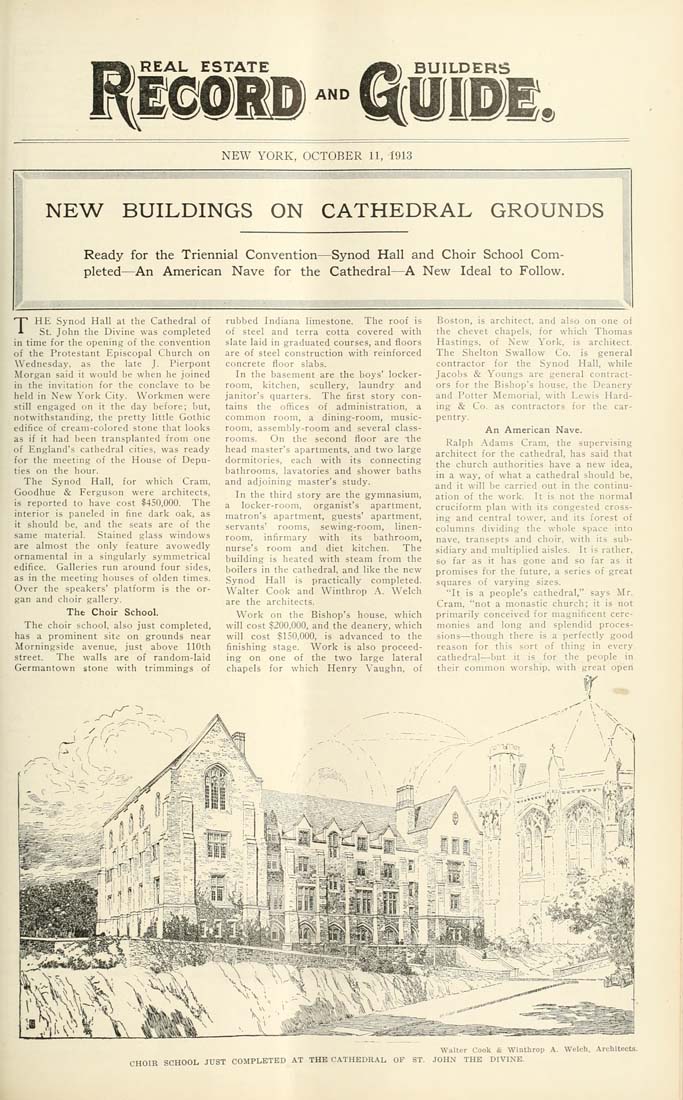Columbia University Libraries Digital Collections: The Real Estate Record
Use your browser's Print function to print these pages.
Real estate record and builders' guide: [v. 92, no. 2378]: October 11, 1913

Text version:
Please note: this text may be incomplete. For more information about this OCR, view About OCR text.
REAL ESTATE BUILDERS AND NEW YORK, OCTOBER 11, 1913 liiiyiiinsBiiiiiiiiH^^^^^ s NEW BUILDINGS ON CATHEDRAL GROUNDS I Ready for the Triennial Convention—Synod Hall and Choir School Com¬ pleted—An American Nave for the Cathedral—A New Ideal to Follow. ■Ill t^ THE Synod Hall al the Cathedral of St. John the Divine was completed in time for the opening of the convention of the Protestant Episcopal Church on W'ednesday. as the late J. Pierpont .Morgan said it would be when he joined in the invitation for the conclave to be held in New York City. Workmen were still engaged on it the day before; but, notwithstanding, the pretty little Gothic edifice of cream-colored stone that looks as if it had been transplanted from one of England's cathedral cities, was ready for the meeting of the House of Depu¬ ties on the hour. The Synod Hall, for which Cram, Goodhue & Ferguson were architects, is reported to have cost $450,000. The interior is paneled in fine dark oak, as it should be, and the seats are of the same material. Stained glass windows are almost the only feature avowedly ornamental in a singularly symmetrical edifice. Galleries run around four sides, as in the meeting houses of olden times. Over the speakers' platform is the or¬ gan and choir .gallery. The Choir School. The choir school, also just completed, has a prominent site on grounds near Morningside avenue, just above 110th street. The walls are of random-laid Germantown stone with trimmings of rubbed Indiana limestone. The roof is of steel and terra cotta covered with slate laid in graduated courses, and floors are of steel construction with reinforced concrete floor slabs. In the basement are the boys' locker- room, kitclien, scullery, laundry and janitor's quarters. The first story con¬ tains the oiSces of administration, a common room, a dining-room, music- room, assembly-room and several class¬ rooms. On the second floor are the head master's apartments, and two large dormitories, each with its connecting bathrooms, lavatories and shower baths and adjoining master's study. In the third story are the gymnasium, a locker-room, organist's apartment, matron's apartment, guests' apartment, servants' rooms, sewing-room, linen- room, infirmary with its bathroom, nurse's room and diet kitchen. The building is heated with steam from the boilers in the cathedral, and like the new Synod Hall is practically completed. Walter Cook and Winthrop A. Welch are the architects. Work on the Bishop's house, which will cost $200,000, and the deanery, which will cost $150,000, is advanced to the finishing stage. Work is also proceed¬ ing on one of the two large lateral chapels for which Henry Vaughn, of Boston, is arcliitect, and also on one of the chevet chapels, for which Thomas Hastings, of New York, is architect. The Shelton Swallow Co. is general contractor for the Synod Hall, while Jacobs & Youngs are general contract¬ ors for the Bishop's house, the Deanery and Potter Memorial, with Lewis Hard¬ ing & Co. as contractors for the car¬ pentry. An American Nave. Ralph .A.dams Cram, the supervising architect for the cathedral, has said that the church authorities have a new idea, in a way, of what a cathedral should be, and it will be carried out in the continu¬ ation of the work. It is not the normal cruciform plan with its congested cross¬ ing and central tower, and its forest of columns dividing tlie whole space into nave, transepts and choir, with its sub¬ sidiary and multiplied aisles. It is rather, so far as it has gone and so far as it promises for the future, a series of great squares of varying sizes. "It is a people's cathedral," says Mr. Cram, "not a monastic church; it is not primarily conceived for magnificent cere¬ monies and long and splendid proces¬ sions—though there is a perfectly good reason for this sort of thing in every cathedral—but it is for the people in their common worship, with great open CHOIR SCHOOL JUST COMPLETED AT THE CATHEDRAL OF ST. Walter Cook & Winthrop A. Welch, .Architects. JOH.N THE DIVINE.